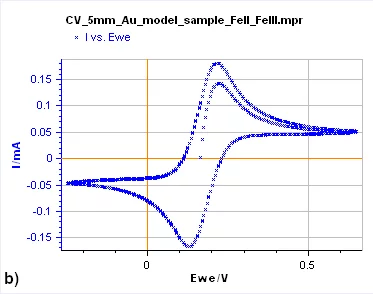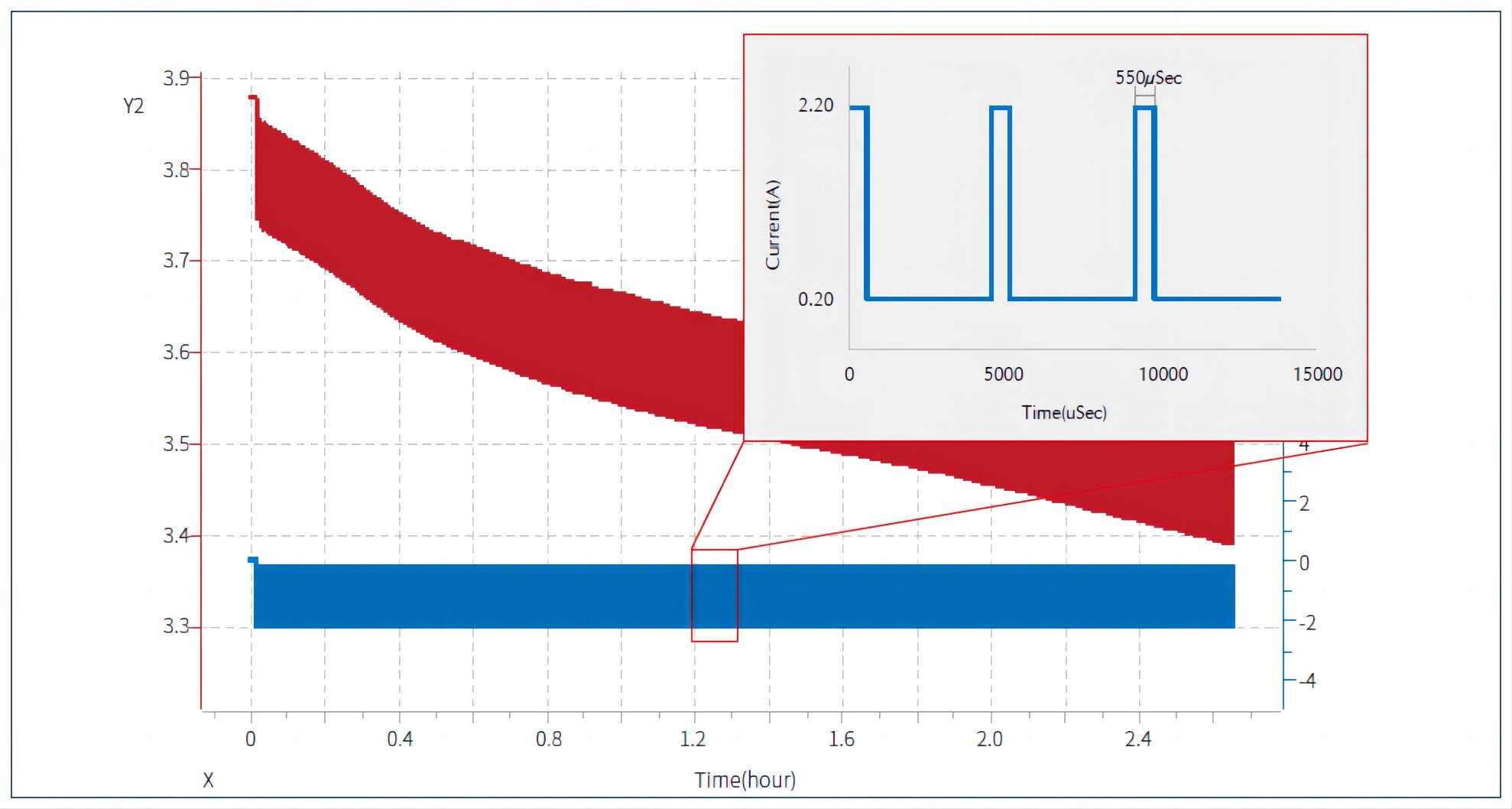
Cyclic voltammetry (CV) is an electrochemical measurement method that applies a triangular waveform pulse voltage to the closed loop formed by the working electrode and the counter electrode. The potential on the working electrode/electrolyte interface is systematically varied at a defined scan rate, inducing oxidation/reduction reactions of the active species present on the working electrode. This allows the measurement of the resulting current response during the electrochemical reaction.
During the CV testing process, several issues may arise, and appropriate measures should be taken to address them:
1.Double-Layer Capacitance: At high scan rates, the capacitive current contribution from the double-layer in the charging and discharging processes can become significant and overshadow the faradaic current response. This can lead to difficulties in accurately analyzing the electrochemical reaction of interest. To address this issue, the scan rate can be adjusted to a lower value to minimize the capacitive current contribution, allowing for better resolution of the faradaic processes.
2.Electrode Fouling or Passivation: Some electrochemical reactions may lead to electrode fouling or passivation, resulting in decreased electrode activity and unreliable CV measurements. To mitigate electrode fouling, proper electrode surface preparation techniques, such as cleaning or polishing, can be employed. Additionally, for passivation, the use of suitable electrolytes or electrode surface modification can prevent or minimize passivation effects.
3.Unwanted Side Reactions: In certain cases, unwanted side reactions may occur during the CV measurement, interfering with the desired electrochemical reaction. These side reactions can lead to inaccurate or misleading results. To minimize unwanted side reactions, careful selection of electrolytes, optimization of electrode materials, or the use of additives can be employed to suppress or control unwanted reactions.
The significance of CV testing lies in its ability to provide valuable information about the redox behavior, electrochemical kinetics, and surface properties of electrode materials. It allows the determination of electrochemical parameters such as peak potentials, peak currents, and charge transfer resistances. CV is widely used in various fields, including electrochemical research, battery characterization, corrosion studies, and sensor development.
CV testing enables the understanding of the electrochemical processes occurring at the electrode-electrolyte interface, aiding in the design and optimization of electrochemical devices and systems. It provides insights into the performance and behavior of electroactive materials, facilitating the development of efficient energy storage systems, electrochemical sensors, and corrosion-resistant coatings.
In summary, cyclic voltammetry (CV) is a valuable electrochemical measurement method that offers insights into the redox behavior of electrode materials. By addressing potential issues and optimizing experimental conditions, CV allows for accurate characterization of electrochemical reactions, aiding in the advancement of various electrochemical applications.
Working condition simulation involves simulating various operational states of electric vehicles, such as acceleration, deceleration, and braking, to perform battery performance tests. This method aims to evaluate the battery's behavior, including its capacity, power output, energy efficiency, and thermal management, under realistic driving scenarios.
During the working condition simulation and battery performance testing, several issues may arise, and appropriate measures should be taken to address them:
1.High Current and Power Demands: Acceleration and rapid braking can result in high current and power demands from the battery. This can lead to voltage drops, increased temperature, and potential degradation of battery performance. To address this, battery systems should be designed to handle high current and power demands, and proper thermal management systems should be employed to dissipate heat effectively.
2.Regenerative Braking and Energy Recovery: Regenerative braking, which involves capturing and storing energy during braking, can pose challenges during testing. The battery should be capable of efficiently accepting the energy generated during regenerative braking and properly managing the charging process. Battery management systems should be implemented to control the charging rate, prevent overcharging, and maximize energy recovery.
3.Realistic Load Profiles: It is crucial to simulate realistic load profiles during acceleration, deceleration, and braking to accurately assess battery performance. The load profiles should consider factors such as vehicle weight, road conditions, driving habits, and traffic patterns. Failure to represent real-world load profiles may lead to inaccurate performance evaluations.
4.Environmental Factors: Environmental factors such as temperature, humidity, and altitude can significantly influence battery performance. Testing should consider these factors and simulate various environmental conditions to assess the performance and behavior of the battery under different scenarios. Temperature control systems and environmental chambers can be used to regulate and replicate specific conditions.
The significance of working condition simulation and battery performance testing lies in their ability to evaluate the performance, energy efficiency, and thermal management of the battery under realistic operating conditions. By simulating different driving states, including acceleration, deceleration, and braking, manufacturers can optimize battery designs, develop efficient thermal management systems, and improve overall system performance.
This testing method allows for the identification of potential issues related to high current demand, energy recovery, and environmental factors. It helps manufacturers assess battery capacity, power output, energy consumption, and thermal characteristics, enabling the development of reliable and efficient electric vehicle power systems.
In summary, working condition simulation and battery performance testing are essential for evaluating the performance and behavior of batteries in electric vehicles. By addressing potential challenges and accurately replicating real-world driving scenarios, this testing method contributes to the advancement of electric vehicle technology, ensuring reliable and efficient operation of batteries in various driving conditions.

Pulse testing is an experimental technique used to assess the performance and capacity of a battery. It involves applying a brief pulse current to the battery, replicating the load changes that occur during actual usage. This method provides valuable insights into the battery's dynamic response to varying load conditions and helps evaluate its power delivery capabilities.
During the pulse testing process, several issues may arise, and appropriate measures should be taken to address them:
1.Voltage Transients: Applying a pulse current to the battery can result in voltage transients or fluctuations. These voltage variations can affect the stability of the power output of the battery and may impact the performance of the connected devices. To mitigate this, voltage stabilization techniques such as using voltage regulators or optimizing battery management systems can be implemented to maintain a stable output voltage.
2.Heating and Temperature Rise: Pulse testing can lead to increased heating and temperature rise within the battery. Excessive heat can affect battery performance, accelerate aging, and even pose safety risks. To address this, proper cooling mechanisms or temperature monitoring systems should be implemented to ensure that the battery operates within safe temperature limits.
3.Capacity Fade and Degradation: Repeated exposure to pulse currents during testing can contribute to capacity fade and degradation over time. This can be caused by factors such as electrode deterioration, electrolyte decomposition, or mechanical stress. To mitigate this issue, manufacturers can optimize the battery design, employ advanced electrode materials, or implement appropriate cycling and conditioning protocols to minimize capacity fade and enhance the battery's longevity.
The significance of pulse testing lies in its ability to evaluate the battery's dynamic response and power delivery capabilities under realistic load conditions. By subjecting the battery to pulse currents that simulate real-world usage scenarios, manufacturers can assess its ability to deliver power efficiently during peak demand situations. This information is crucial for designing batteries that can meet the performance requirements of various applications, such as electric vehicles, portable electronics, and renewable energy storage systems.
Pulse testing also aids in the development of battery management systems, charging algorithms, and power delivery optimization. It allows manufacturers to identify potential limitations, optimize the battery's performance under dynamic load conditions, and enhance the overall reliability and efficiency of batteries.
In conclusion, pulse testing is a valuable method for evaluating battery performance and power delivery capabilities under dynamic load conditions. By simulating load changes through pulse currents, this testing technique helps optimize battery designs, assess performance limitations, and ensure the reliable operation of batteries in real-world applications.




The lab focuses on solid-state battery research to overcome traditional lithium batteries' safety and energy density issues, supporting environmental sustainability. It develops innovative solid-state electrolytes, refines electrode materials, and investigates ion transfer and interface stability to revolutionize battery technology.

The electric vehicle battery industry is rapidly developing, focusing on technological innovation, market competition, and sustainability. Research hotspots include solid-state batteries, new types of electrolytes, BMS optimization, and recycling technologies. The environmental adaptability, safety, and economic viability of batteries are key research areas, and the industry is expected to undergo more innovation and transformation.

Specializing in battery preparation technology research, the focus is on overcoming existing energy storage challenges by innovating in electrode materials, battery chemistry, and manufacturing processes to improve performance, safety, and reduce costs. Sustainability and recycling technologies for batteries are also emphasized to mitigate environmental impacts and foster the growth of green energy.